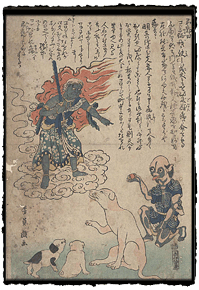Religion and Health
by Laura W. Allen
Many of the prints in
the collection reflect the belief in deities as causative agents of disease:
both smallpox and measles "gods" are shown again and again as forces to be
appeased, if not forcibly repelled. A
second, related category of prints reflects the inverse of this idea, by
showing Shinto or Buddhist deities who lead or sanction the fight against
disease.
 An 1858 print by Yoshikazu, titled "Various protective gods help good drugs
cure vicious diseases," depicts a battle between a group of armed soldiers and
their weak-looking opponents, semi-naked men in simple white robes piled
helter-skelter on the shoreline as they are attacked with bows, arrows, and staves. The soldiers' heads are spheres,
labeled with the names of various medicines (semen, or santonin, is one, hiyosu,
or henbane is another), while the enemy, given grimacing human heads, are
labeled food poisoning, stomach-ache, dropsy, and so on. An 1858 print by Yoshikazu, titled "Various protective gods help good drugs
cure vicious diseases," depicts a battle between a group of armed soldiers and
their weak-looking opponents, semi-naked men in simple white robes piled
helter-skelter on the shoreline as they are attacked with bows, arrows, and staves. The soldiers' heads are spheres,
labeled with the names of various medicines (semen, or santonin, is one, hiyosu,
or henbane is another), while the enemy, given grimacing human heads, are
labeled food poisoning, stomach-ache, dropsy, and so on.
Seemingly directing the
battle from above is a figure labeled gyūtō
tennō, or Emperor Cowpox [Vaccine].
He directs the soldiers with a tree branch, as he leads a procession of
seven Shinto deities from the heavens.
In other words, it is through their intercession that the medicines are
effective.
Other prints from the
collection similarly include Shinto deities overseeing the suppression of
disease.
 One print depicts the
Buddhist deity, Acala — in Japanese, Fudō myōō — warding off
cholera. Fudō myōō
is also mentioned in some of the drug advertisements, as the creator of the
drug being advertised. Buddhist imagery
appears in several of the prints in the collection. One print depicts the
Buddhist deity, Acala — in Japanese, Fudō myōō — warding off
cholera. Fudō myōō
is also mentioned in some of the drug advertisements, as the creator of the
drug being advertised. Buddhist imagery
appears in several of the prints in the collection.
|
|
|

